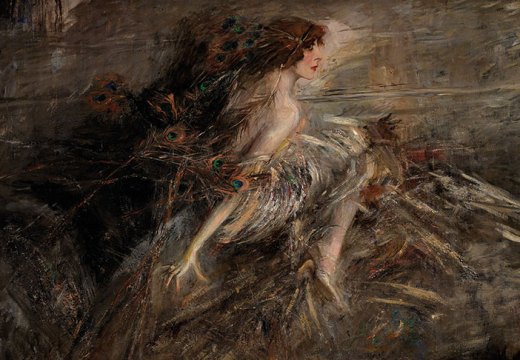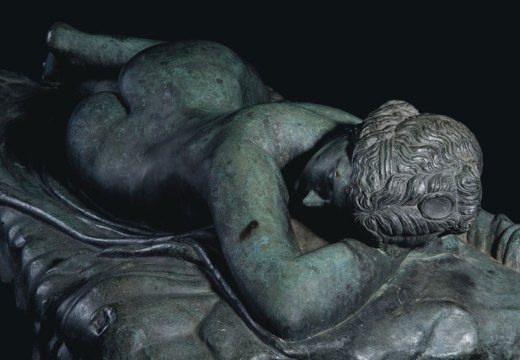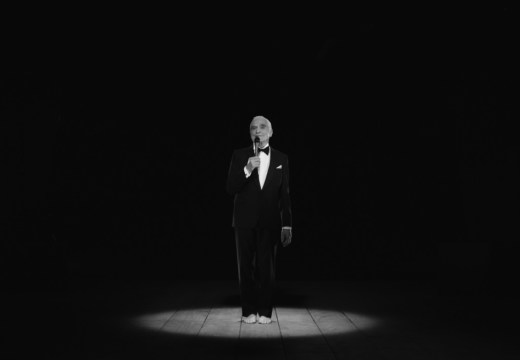From the April 2023 issue of Apollo. Preview and subscribe here.
Félix Vallotton’s Le Sommeil (‘Sleep’, 1908) is currently not hanging on the walls of the Musée d’Art et d’Histoire in Geneva, where it normally lives, but instead is sitting on the floor of what is better known as the museum’s sculpture gallery. This is part of Ugo Rondinone’s intervention throughout the museum, reactivating rooms, highlighting what they are now and summoning what they’ve been before. These massive rooms were dedicated to presenting sculpture. This is why they have huge windows, and there is a strange communication between this part of the museum and the outside environment. Rather than using the walls, Rondinone has produced low pedestals in order to have a group of Vallotton paintings presented almost as though they are sculptures. It changes the way you see the picture.
You understand that the woman is painted almost lifesize. Strangely, this isn’t obvious when the painting is hanging on the wall. But as you get up close you get the full measure of its human size. This new arrangement brings the painting near you and makes it feel very contemporary.
At the time Vallotton was producing this series of nudes, people were a little bit shocked by them. The physique of Vallotton’s models was part of the problem – they weren’t keen on showing non-idealised bodies as nudes. Of course, this kind of thing feels very contemporary and reminds us how striking Vallotton’s vision is. It is so contemporary to have a body that seems to be totally natural and a real person, especially when you see it as one of 10 other bodies in the same room, all lined up together, almost like painted sculptures.
It is up to the viewer how they approach the gallery. They could start with these female nudes or they could come from the other side and start with the male body, in the guise of Ferdinand Hodler’s Guerrier à la hallebarde (‘Warrior with a halberd’, 1895–96). They can choose between the images and the effect of the sculptural strangeness. The oddness of the display and the coolness of the images are amplified by the fact that each window of this space has a light-blue filter. This is derived from a work by Rondinone called Love Invents Us, originally made in 2000, in which every window of a room was covered with a filter, from blue to red.

Le Sommeil on display as part of the exhibition ‘Carte blanche to Ugo Rondinone: when the sun goes down and the moon comes up’ at the Musée d’Art et d’Histoire, Geneva, in 2023. Photo: I. Popa; © MAH
The coolness that Rondinone chooses to bring out in this room helps to emphasise a coolness and distance typical of Vallotton. This quality comes, I think, from the technique he had developed as a print illustrator. From 1891 to 1901 Vallotton produced more than 120 woodcuts, the majority in black and white. The process of colouring woodcuts is to work in flat planes of colours – the print-maker can add perhaps one or two areas of colour that are printed on top of each other. You see something of this effect in Le Sommeil, with its planes of flat, tight reds and blues. Even the body of the girl seems flat, and something about her position overplays that flatness.
This use of colour is, in my opinion, what is really modern about this work. This is a work, after all, that was painted before abstraction, and yet around the same time artists were thinking about the temperature of colour and the effect colour might have on bodies, on behaviour, on relationships.
It is possible that he’s alluding to his work as an illustrator through the presence of the book on the floor. This book could be a normal, everyday companion. It looks as though it could be a work of classical French literature. Yet books with yellow covers come with certain other suggestions – it is hard to disassociate it from lascivious French ‘yellow books’ of the late 19th century. Perhaps speculation of this sort is exactly what Vallotton is intending, which suggests his flair for illustration. Within the painting there are so few elements to attach to a narrative that you are forced to engage in acts of interpretation to establish what has happened in the scene before you.
But the work is not entirely flat when you get up close. If you face the painting in the flesh, as it were, you see that there are different reds used across the canvas. But what is very impressive is that near the cushion you have a very straight line which seems to be drawn like a line crossing the whole painting, nearly cutting into the model’s back. It’s a very sharp line. The line seems to be reflexive, in a way – it’s inviting the viewer to be aware that they are looking at a painting. He deploys a similar trick in other works. For example, in Le Bain Turc [‘The Turkish Bath’, 1907], a lot of women bathing alone except for a small dog. If the painting is hanging at the correct height the viewer and the dog have the same viewpoint. The viewer cannot escape from the middle of the painting, which is exactly where the dog is looking, so by some metaphorical extension, the viewer becomes the dog. They are placed directly, brutally and quite roughly in the scene of the painting. In a similar way, that sharp, straight line draws the viewer into the position of the sleeping model.
What I like personally, which is something very strange that I only noticed as part of the Ugo Rondinone show, is that the position of the girl allows you to read the body of the model differently. While the hairstyle signifies a woman, it’s possible that the body is more fluid than you might initially think.
At the risk of over-interpreting, there is a tension in the life of Vallotton that is perhaps expressed in a detail of this painting, the fragment of carpet seen at the bottom of the work. He was anti-bourgeois – he produced satirical woodcuts and distributed them through leftist newspapers in Paris. He lived in the Latin Quarter, in a relationship with a seamstress, Hélène Châtenay. But then, when he was 33, he left Hélène, to the surprise of his bohemian friends, and married a Jewish widow with three children, Gabrielle Rodrigues-Henriques, a woman of irreproachable bourgeois sensibility and, not un-usefully, the sister of an art dealer in Paris. Perhaps we see in the bold, revolutionary red of the cushions and the fragment of bourgeois carpet an artist trying to resolve two strands of his life.
As told to Edward Behrens.
Samuel Gross is curator in charge of exhibitions at the Musée d’Art et d’Histoire, Geneva.
‘Carte blanche to Ugo Rondinone: when the sun goes down and the moon comes up’ is at the Musée d’Art et d’Histoire until 18 June. For more details, visit www.institutions.ville-geneve.ch/fr/mah.
From the April 2023 issue of Apollo. Preview and subscribe here.
Unlimited access from just $16 every 3 months
Subscribe to get unlimited and exclusive access to the top art stories, interviews and exhibition reviews.














![Masterpiece [Re]discovery 2022. Photo: Ben Fisher Photography, courtesy of Masterpiece London](http://www.apollo-magazine.com/wp-content/uploads/2022/07/MPL2022_4263.jpg)
It’s time for the government of London to return to its rightful home